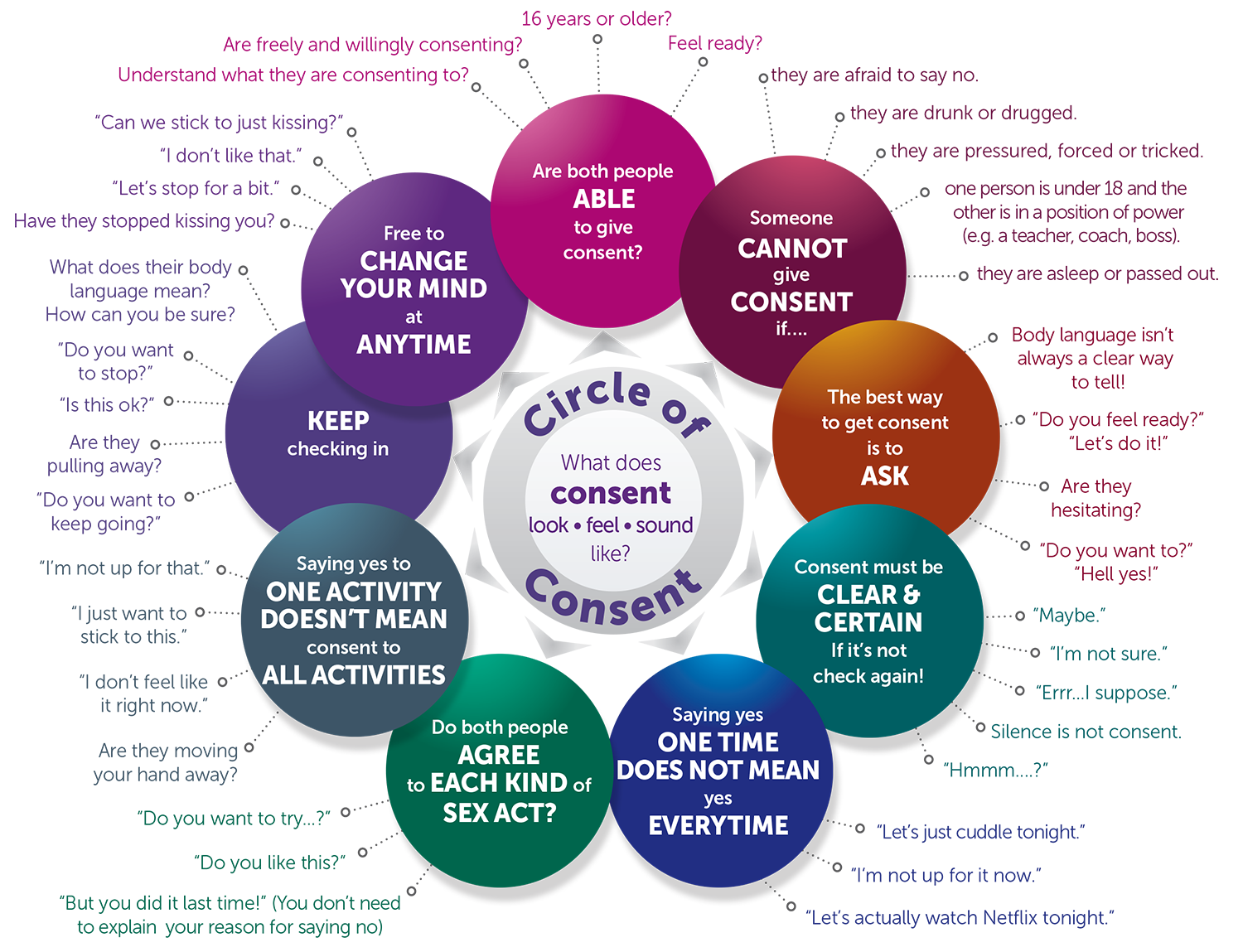It’s time to have a conversation about consent and respectful relationships.
One of the most important conversations we need to have with our children is about sexual consent. Simply put, sexual consent is an agreement to engage in sexual activity.
Consent is:
- Mutual
- Freely given
- Informed
- Certain and clear
- Enthusiastic
- Reversible
- Specific
- Ongoing
Source: kidshelpline

Source: Talk Soon, Talk Often p18
Schools should specifically teach their students about sexual consent in the Health curriculum, but as parents you play the major role in ensuring there is clarity for your child in regard to what sexual consent is, and also what the law states. In this position paper we outline:
- What students may be taught at school
- What the law states about sexual consent
- How to have a conversation with your child about consent
What schools may teach to students – a snapshot
An understanding of consent begins with children learning ways to keep themselves safe – commonly termed protective behaviours. This involves helping students recognise when they don’t feel safe (physically and emotionally) and exploring what they can do to feel safe again.
In the early years, an understanding of body safety and, more specifically, an understanding of personal boundaries, body awareness and ownership is important. The school psychologist, in conjunction with the classroom teacher, may deliver sessions that cover various protective behaviour themes such as early warning signs, safe and unsafe touch, personal space, safe and unsafe secrets and assertiveness skills. Focus can also be on developing a safety network, that is a group of adults (chosen by the child), who can provide them with support, assistance and, if necessary, protection.
Some secondary schools have devised Respectful Relationship curriculums. The focus of which is to promote positive relationships built on respect. For example, a unit taught within the curriculum may focus on ‘Sex and the Law’ covering topics such as: understanding sexual behaviour, recognising and understanding the law in relation to consent (including age of consent) as well as how to get help or ask questions. As students’ progress through secondary school, they can explore different scenarios in a safe and age-appropriate way.
Contact your school if you would like further information on their curriculum.


What the law says
The age of consent is the age where you are legally able to have sex.
A Summary of Consent
- It is never okay for a person to have sex with another person who is under 12 years old.
- If you are aged 12-15 years old, you can legally have sex with another person who is less than 2 years older than you (as long as you both actively agree to it).
- Once you turn 16, you can legally have sex with another person who is also aged 16 years or older (as long as you both actively agree to it).
- Also, a person in a position of care or authority e.g. a teacher, parent, step-parent, guardian, counsellor, doctor or sports coach cannot have sex with a person aged 16-17 years old under their care.
Source: https://yla.org.au/vic/topics/health-love-and-sex/sex/
Parenting: respectful relationships and understanding boundaries
According to a recent Harvard University study, generally it was found parents were not discussing basic issues related to consent (Wesissbond et al, 2017).
Research shows that:
- Parents often feel their kids will come to them, but children want parents to initiate these conversations
- Successful communication with your child occurs when you are clear and direct and when you listen and invite questions
- If your child is same-sex attracted, it can be very upsetting if the parent does not raise the subject
Source: Wildman et al 2015
Where to start?
Teaching about the factors that contribute to an understanding of consent can, and should, occur from an early age. These factors include: body awareness, privacy, labelling of body parts, what is and isn’t okay in terms of boundaries, as well as how men and women are depicted in life and culture. We know that even as early as ages 2-3, gender labelling occurs (Kuhn et al, 1978) and that children’s sense of how gender intersects with different roles and qualities (masculinity is ‘hard’ and femininity is ‘soft’) occurs (Leinbach et al, 1997).
Home is where our children feel safe. It provides the context for many moments we can talk about including boundaries, gender and consent. While children learn about sexuality at school, they also learn about it online. Sadly, there is a very high chance your child will be able to see sexually explicit images, pornography or worse. With the amount of time many children spend online, it is important for parents to provide the message that: we treat people with respect and you can always talk to me if you are concerned or worried about anything.
To provide you with some guidelines, here is a summary drawn from Healthline and Talk Soon Talk Often resources. As this is a guide, should you require further assistance and specificity, please contact a health professional.
How you can help
In the early years:
- Use the correct labelling for body parts. When we use different or coded words, it can cause confusion and make it seem as though there is something secretive about our bodies.
- Reinforce the idea of body ownership: every individual has control over his or her body
- A simple action is to underline that ‘no means no.’ If your child asks you to stop tickling them, model that.
- Talk to your child about the importance of ‘telling’ and that different levels of access are okay. For instance, a hug from mum or dad is different to that of a stranger.
In the upper primary/lower secondary years:
- In these years, it is possible to talk about permission, consent and coercion. You can talk about physical boundaries, but also personal boundaries.
- You can talk about gender roles and responsibilities. This is important as a lack of understanding of diversity of roles and responsibilities can lead to misconceptions about consent (for example, that men are dominant).
- In films, where objectification occurs, talk openly with your child about the way in which the characters are portrayed and what that means
Middle to later secondary years
- Talk about power dynamics in relationships and what a healthy relationship looks like
- Check in with your child about the content they have covered at school
- Discuss the role of alcohol (and drugs) and the potential effect this can have on the understanding of boundaries and giving, as well as providing, consent.
As the Harvard report states, ‘these conversations often don’t need to be painfully awkward, deliberate, face-face conversations. There are countless opportunities to address these issue more informally’ (Wesissbond et al, 2017).
Some further important contacts
- Kids Helpline provides free and private counselling to young people up to age 25. You can talk to them about anything that’s affecting you at any time, day or night on 1800 55 1800.
- 1800Respect is a national helpline, providing counselling, information and support. You can call them on 1800 737 732, 24 hours a day, 7 days a week.
- 1800MYLINE is a national helpline for sexual assault, family and domestic violence, available 24/7. They provide counselling, advice, or referrals to helpful services. You can call them on 1800 695 463, 24 hours a day, 7 days a week.
- Family Planning Victoria is a clinic that provides sexual healthcare (safe sex) services and advice. You can them on (03) 9257 0100 or e-mail them at fpv@fpv.org.au
- SECASA – South Eastern Centre Against Sexual Assault 9928 8741 or visit website www.secasa.org.au
References
Teach your child how to keep themselves safe Commission for Children and Young People www.ccyp.vic.gov.au. Accessed 2021.
Widman L, Choukas-Bradley S, Noar SM, Nesi J, Garrett K. (2015) Parent-adolescent sexual communication and adolescent safer sex behaviour: a meta-analysis. JAMA Paediatrics
Sex Youth Law Australia https://yla.org.au/vic/topics/health-love-and-sex/sex/. Accessed 2021.
Sex, Young People and The Law Education Kit (2020). Victorian Legal Aid. Accessed 2021.
Resilience, Rights and Respectful Relationships Curriculum (2018). Published by the Victorian Department of Education and Training. Accessed 2021.
How to teach your teenager about consent (2021). Reachout.com https://parents.au.reachout.com/common-concerns/everyday-issues/things-to-try-talking-about-sex/how-to-teach-your-teenager-about-consent. Accessed 2021.
What is consent? (2021). Kidshelpline. https://kidshelpline.com.au/teens/issues/what-consent. Accessed 2021.
Toddlers and early elementary kids (2018) Heathline.com. https://www.healthline.com/health/parenting/consent-at-every-age#toddlers-and-early-elementary. Accessed 2021
Weissbourd R, Ross Anderson T, Cashin A, McIntyre J (2017) The Talk: How Adults Can Promote Young People’s Healthy Relationships and Prevent Misogyny and Sexual Harassment Harvard University Graduate School of Education. Harvard University Press.
Kuhn D, Nash SC, Brucken L (1978) Sex role concepts of two- and three-year-olds. Child Dev.
Signorella ML, Bigler RS, Liben LS. (1993) Developmental differences in children’s gender schemata about others: a meta-analytic review. Dev. Rev.
Resources
The role of the parent during this time of change
What should you be focusing on?
Do you want to be part of our Staff Development Network?
Sign up to receive our newsletter
